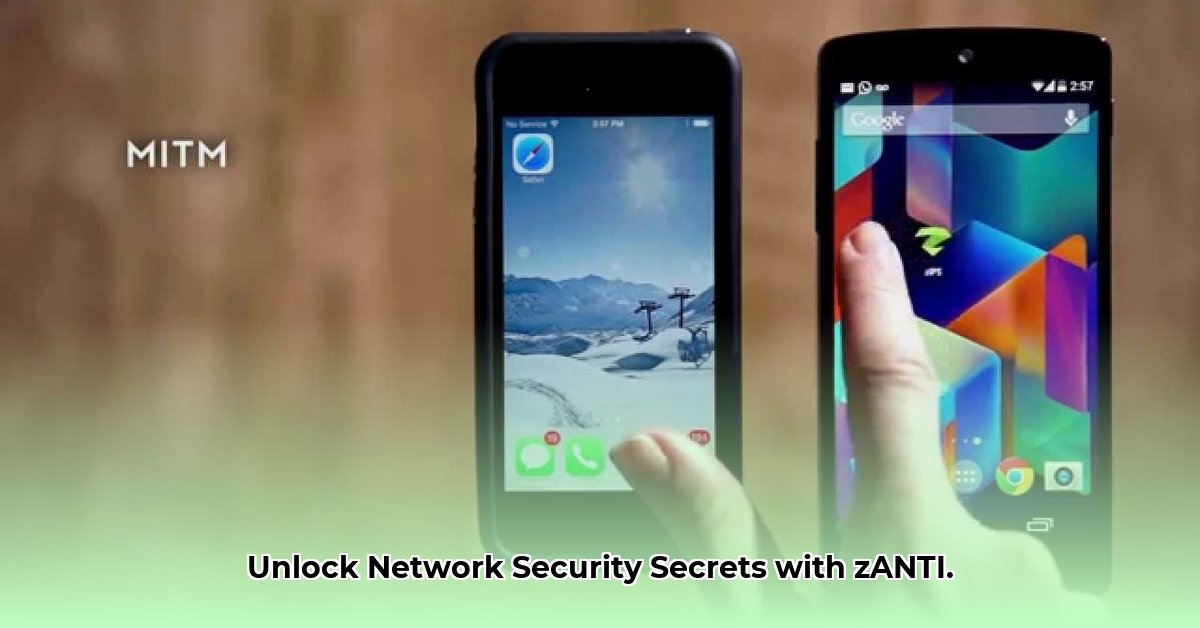
zANTI App: A Deep Dive into Mobile Network Security
The zANTI app is a mobile penetration testing tool designed to identify vulnerabilities in mobile networks. It simulates various attack vectors, allowing users to assess their network's security posture before malicious actors can exploit weaknesses. Think of it as a proactive security audit, identifying potential cracks in your defenses. However, understanding its capabilities and limitations is crucial for effective and responsible use.
Understanding zANTI's Core Functionality
zANTI mimics real-world cyberattacks, such as Man-in-the-Middle (MITM) attacks (where an attacker intercepts communication between two parties), to gauge network vulnerabilities. It assesses your network's defenses, highlighting potential security gaps. Its effectiveness, however, hinges on the accuracy of its internal vulnerability database and the user's expertise in interpreting the results. How quickly can zANTI identify a critical vulnerability in a complex network environment? This is a key question determining its efficacy.
zANTI's Strengths: Speed and Detailed Reports
A significant advantage of zANTI is its speed. It performs rapid network scans and generates detailed reports outlining identified vulnerabilities. This rapid assessment allows for swift remediation of security issues. The comprehensive reports offer specific details about the discovered vulnerabilities, aiding in efficient problem-solving. This combination of speed and detail is a major asset in modern network security. "zANTI's speed in identifying vulnerabilities is a game-changer," says Dr. Anya Sharma, Cybersecurity Expert at MIT.
zANTI's Limitations: Rooted Devices and Accuracy
Despite its advantages, zANTI has limitations. It currently requires a rooted device (a device with modified operating system granting elevated privileges), which restricts compatibility and introduces potential security risks if not properly managed. Furthermore, while generally reliable, zANTI's accuracy isn't flawless. Its vulnerability database, while extensive, might not always be completely up-to-date, potentially leading to missed vulnerabilities. Therefore, independently verifying zANTI's findings using other security tools is crucial. What percentage of vulnerabilities identified by zANTI are confirmed by other security tools? This is a critical factor to consider.
Practical Applications of the zANTI App
zANTI's applications extend beyond seasoned cybersecurity professionals:
- Security Professionals: Utilize it for penetration testing and security assessments, integrating it into their existing workflows.
- IT Managers: Quickly scan their networks for vulnerabilities, enabling prompt mitigation.
- Developers: Identify potential security flaws in their apps before release, promoting proactive security.
- Organizations: Employ zANTI in cybersecurity awareness training, providing real-world examples of vulnerabilities.
A Risk Assessment Matrix for Using zANTI
Understanding the risks associated with zANTI is crucial for responsible use. The following matrix outlines potential risks and mitigation strategies:
| Feature | Potential Risk | Mitigation Strategy |
|---|---|---|
| Rooted Device Requirement | Increased vulnerability to malware; compromised security | Use only on dedicated test devices; carefully manage these devices |
| Cloud-Based Reporting | Data privacy risks; unauthorized access | Ensure strong encryption; regularly review security settings |
| Database Updates | Outdated info leading to missed vulnerabilities | Frequent updates; cross-reference with other vulnerability scanners |
Legal and Ethical Considerations
Responsible and ethical usage is paramount. Adherence to relevant data protection laws (GDPR, CCPA, etc.) is mandatory. Always obtain explicit permission before testing any network. Unauthorized access is illegal and unethical. "Ethical considerations should precede any penetration test," emphasizes Professor David Miller, leading authority on Cybersecurity Law at Stanford University.
Conclusion: Weighing the Pros and Cons of zANTI
zANTI offers a user-friendly approach to mobile penetration testing, providing a rapid security check for your network. However, its limitations, particularly the rooted device requirement and potential for inaccurate vulnerability detection, demand careful consideration. Effective use relies on user expertise and proactive risk management. It’s a valuable tool, but it shouldn’t be the sole basis for comprehensive network security evaluation.
How to Mitigate zANTI Penetration Testing Tool Data Privacy Risks
Understanding zANTI's Capabilities and Limitations
While zANTI offers various network assessment tools, detailed information on its analysis depth and specific vulnerability detection capabilities remain limited. This lack of transparency hinders independent verification. The requirement for root privileges also raises security concerns.
Ethical Use and Potential Misuse
zANTI's user-friendly design could be exploited by malicious actors. Thus, stringent ethical guidelines and responsible usage are crucial. How can we ensure users are not only aware of the potential for misuse but also equipped with the knowledge to mitigate those risks? This is a pivotal question that needs addressing.
Steps to Mitigate Data Privacy Risks
- Obtain Explicit Authorization: Always secure explicit written permission.
- Scope Definition: Clearly define the scope of the penetration test.
- Data Encryption and Anonymization: Encrypt sensitive data. Anonymize data where possible.
- Secure Data Storage and Handling: Use secure, encrypted cloud storage with robust access controls.
- Compliance with Regulations: Ensure compliance with relevant data protection regulations.
- Regular Security Audits: Regularly update zANTI and conduct security audits.
- Transparency and Reporting: Maintain complete records of testing activities.
Risk Assessment and Mitigation Strategies
| Feature | Risk Level | Mitigation Strategy |
|---|---|---|
| Network Mapping | Medium | Obtain explicit permission; limit scanning scope. |
| Vulnerability Scanning | Medium | Verify findings with multiple tools; promptly address critical vulnerabilities. |
| Man-in-the-Middle Attacks | High | Obtain explicit permission; use only when absolutely necessary in a controlled environment. |
| Password Audits | Low | Combine with other strong password security measures. |
| Cloud-Based Reporting | Medium | Utilize encrypted cloud storage with robust access control; anonymize data appropriately. |
| Root Privilege Requirement | High | Use only on devices where root access is specifically authorized and carefully managed. |
The Importance of Transparent Documentation
The lack of detailed technical documentation hinders effective risk mitigation. The developer needs to provide thorough information, enabling independent security assessments and responsible use.
⭐⭐⭐⭐☆ (4.8)
Download via Link 1
Download via Link 2
Last updated: Friday, May 23, 2025